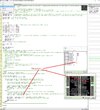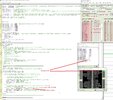This only applies to Timers, CCP values don't increment. If by some rare coincidence writing the low byte first causes a match then it will be cleared lower down before exiting the ISR. I don't know if Oshonsoft will write a 16 bit register or if it will need splitting, depends on the compiler.The only things I can see with his version are:
When reading 16 bit registers one byte at a time, you must read LOW byte first.
When writing them, you must read HIGH byte first.
(The high byte is transferred via a latch to synchronise the two halves).
The conversion (?) has some strange bits like,
Code:
'T1CON=0b00000001; 'timer 1 clocks at
T1CON.7 = 0 '7=RD16 0 = Enables register read/write of Timer1 in two 8-bit operations
T1CON.6 = 1 'T1RUN 1 = Device clock is derived from Timer1 oscillator
T1CON.5 = 1 'T1CKPS.5-4 10 = 1:4 Prescale value
T1CON.4 = 0
T1CON.3 = 1 'T1OSCEN 1 = Timer1 oscillator is enabled
T1CON.2 = 0 'T1SYNC This bit is ignored. Timer1 uses the internal clock when TMR1CS = 0.
T1CON.1 = 0 'TMR1CS 0 = Internal clock (FOSC/4)
T1CON.0 = 1 'TMR1ON 1 = Enables Timer1and,
Code:
INTCON.PEIE = 1 '[6]PEIE/GIEL: Peripheral Interrupt Enable bit: When IPEN = 1: 1 = Enables all low-priority peripheral interrupts
INTCON.GIE = 1 '[7]GIE/GIEH: Global Interrupt Enable bit: When IPEN = 1:1 = Enables all low-priority peripheral interrupts
Enable High 'This is set for SERVOS
Enable Low 'This is set for GPS laterI also note that your code enables interrupt priority.
Mike.
Edit, the CCP1CON value is wrong too.
Last edited:



